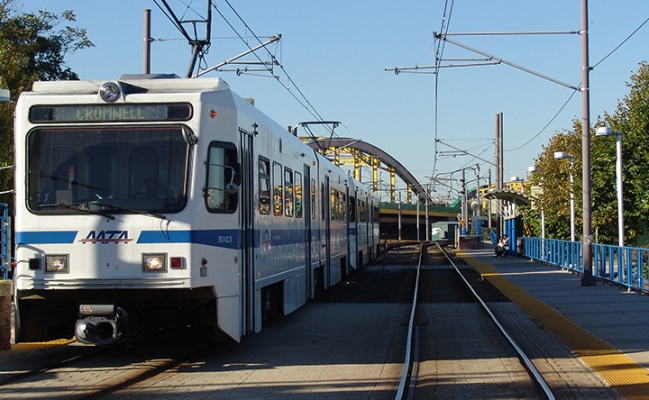The video begins at 0:29.
View slides
Speaker: Brian Saelens, Professor of Pediatrics and Psychiatry & Behavioral Sciences, Seattle’s Children’s Hospital & University of Washington
Topic: Links Between Public Transportation and Physical Activity (Effects of LRT on Physical Activity Based on Seattle GPS Study)
Summary: This seminar will explore the empirical evidence regarding the links between the use of public transportation and physical activity, with a specific focus on using integrated device and self-report methods to identify travel modes and physical activity.
Bio: Brian E. Saelens, Ph.D. is a Professor of Pediatrics and Psychiatry & Behavioral Sciences at the University of Washington and Principal Investigator at Seattle Children’s Research Institute. Dr. Saelens is a clinical/health psychologist. His interest areas include obesity treatment and prevention, especially in environmental factors and policies that influence physical activity and eating behaviors in children and adults. He has published over 150 peer-reviewed original investigation and review articles.
The video begins at 2:16.
Abstract: Reliance on the automobile for most trips contributes to costly trends like pollution, oil dependence, congestion, and obesity. Germany and the U.S. have among the highest motorization rates in the world. Yet Germans make a four times higher share of trips by foot, bike, and public transport and drive for a 25 percent lower share of trips.
This presentation first investigates international trends in daily travel behavior with a focus on Germany and the USA. Next, the presentation examines the transport and land-use policies in Germany over the last 40 years that have encouraged more walking, bicycling, and public transport use. Using a case study of policy changes in the German city of Freiburg, the presentation concludes with policies that are transferable to car-oriented countries around the world.
Bio: Ralph Buehler is Assistant Professor of Urban Affairs & Planning and a Faculty Fellow with the Metropolitan Institute at Virginia Tech in Alexandria, VA. Originally from Germany, most of his research has an international comparative perspective, contrasting transport and land-use policies, transport systems, and travel behavior in Western Europe and North America. His research falls into three areas: (1) the influence of transport policy, land use, socio- demographics on travel behavior; (2) bicycling, walking, and public health; and (3) public transport...
Read moreThe video begins at 3:14.
View slides
Abstract: As part of Clark County Public Health’s Planning Active Walkable Neighborhoods project, a Health Impact Assessment (HIA) was conducted on the county’s Bicycle and Pedestrian Master Plan. A rapid HIA was completed to provide input on the draft plan, and a subsequent comprehensive HIA was designed to evaluate the impacts of final proposals. This presentation will provide an overview of the process and results of the HIA, examine lessons learned, and discuss transferability to other jurisdictions or projects.
The video begins at 2:56.
Abstract: Genesis of America's First "Platinum Bike City", Davis CA
Before there was "Portland, Bike City USA" there was "Davis, Bicycle Capital of America."
Davis and Portland are very different places. Portland is big, old, industrial. Davis is small, new, nerdy. Portland has hills and rain. Davis is flat and dry. But they are both places where people bicycle. A lot. Ordinary folks come to these cities and often start riding a bike. Bicycling in Davis began in the 1950s, when it was a tiny city with the UC agricultural campus. As the city grew, citizens demanded bicycle infrastructure. After years of negotiation, city authorities gave in to pressure and instructed their staff to begin providing for bicycles. Everything had to be designed from the ground up. America had very little bike infrastructure, but that didn't stop Davis from trying dozens of different types of lanes, paths, intersection treatments, etc., and devising workable solutions. So workable, in fact, that they became the California standard, and then the American standard. As America was adopting Davis's designs, Davis continued to promote and accomodate bicycling on many levels, and in 1980 28% of the population commuted by bike.
Now, Davis and Portland are both rated "Platinum" cities for bicycling by the League of American Bicyclists. But they're still as different as night and day. Portland...
Read moreView slides
If you would like to receive continuing education credits such as PDH or CM, please make sure to complete this evaluation form once you've watched the entire video so that we have a record of your attendance.
Watch video:
Read moreThe video begins at 1:32.
Topic: Four Types of Cyclists: What do we know and how can it help?
Labeling or categorizing cyclists has been occurring for over a century for a variety of purposes. Dr. Dill's research aimed to examine a typology developed by the City of Portland that includes four categories: Strong and the Fearless, Enthused and Confident, Interested but Concerned, and No Way No How. Unlike several other typologies, this widely referenced typology is intended to apply to all adults, regardless of their current cycling behavior. This seminar will present her findings, focusing on differences between the four types and a better understanding the market for increasing cycling for transportation.

